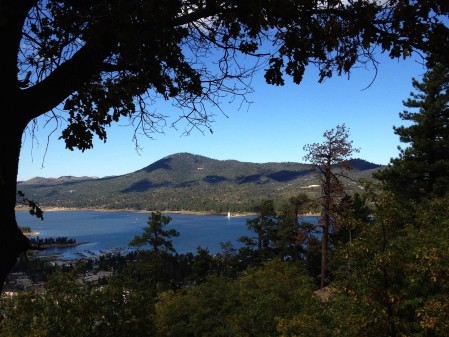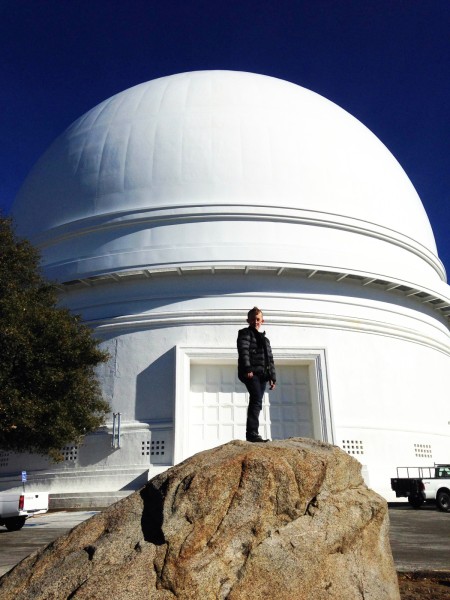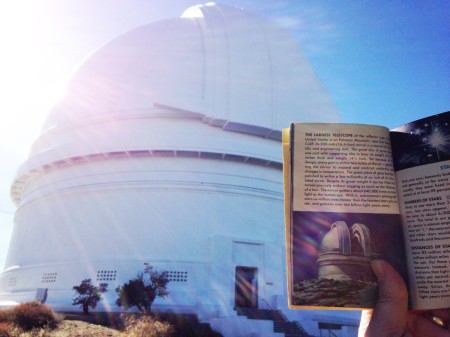
I have been fortunate to visit two of the great research observatories in California: Lick Observatory on Mount Hamilton, overlooking San Jose, which got me into all this in the first place; and Mount Wilson Observatory, where I’ve gotten to observe twice with the 60-inch telescope.
For a long time I have been meaning to get to the third major research observatory in California: Palomar. The building of the 200-inch (5-meter) telescope during the Great Depression was one of the first scientific “megaprojects”, something akin to the Apollo program or the search for the Higgs boson, and it caught the public interest in much the same way. After serious war-related delays, the great machine was finally dedicated in 1948, had its official first light in 1949, and started regular research observations in 1950–a program that continues to this day. The 200-inch telescope was absolutely the world’s largest telescope from 1948 to 1976, and effectively the world’s largest telescope until the first Keck telescope came online in 1993. The 6-meter Soviet BTA-6, which was completed in 1976, was more of a publicity stunt than a functional instrument and has not lived up to its potential, although I hear it is being overhauled so maybe that will finally change.
If you are remotely interested in the history of big telescopes in general and the history of the 200-inch in particular, I highly recommend The Perfect Machine, by Ronald Florence. If I started relating all the interesting anecdotes about the building of the telescope, we’d be here forever–it will be faster and more enjoyable to read the darn book.
Anyway, yesterday I was staring down the barrel of a 3-day weekend with no definite plans. I decided that it was finally time to go see the “big eye” at Palomar Mountain. London and I didn’t get on the road until early afternoon, so we got down there too late to visit the observatory yesterday. Instead, we went to nearby Palomar Mountain State Park for a phenomenal sunset and some early evening stargazing.
I had along a new toy: Vicki loaned me her Nikon D70 DSLR. She’s had it for three or four years, I’ve just never used it. It’s been on my to-do list, though, and Kevin’s results on Mount Baldy a couple of weeks ago gave me just the kick that I needed. I have been waiting not-s0-patiently for the full moon to pass so that I could try my hand at photographing constellations.

London in the meadow by Doane Pond, with the handle of the dipper hanging overhead.
After sunset London and I went down to Doane Pond, which sits in a nice little bowl with mountains on all sides. We went on a night hike around the pond, which resulted in us accidentally scaring several bullfrogs and them scaring us right back–few things are more alarming than an unsuspected animal making sudden noisy movement right by your feet in the dark. I also stopped at various places around the pond to photograph the sky, the pond, or the sky reflected in the pond.
I should preface all this by saying that I have no idea what I’m doing. This is my first time using a DSLR, I have no idea what about 95% of the controls do, and if you actually know photography you’d best put your beverage down now so you don’t spit it all over the keyboard. Nevertheless, I have read that one can get passable constellation photos with exposures of 30 seconds or less, and you are about to see my first round of results.
I’ve been rereading Leslie Peltier’s Starlight Nights. I think of it, and Timothy Ferris’s Seeing in the Dark (the subject of this previous post), as “books about the why”. Loads of books will tell you how to stargaze, but very talk about the actual thoughts and emotions associated with the practice. If you want to know why to stargaze, go read Starlight Nights and Seeing in the Dark. Just be warned–if you’re not a stargazer now, you may be one by the time you’re done (also, if you’re not, I don’t know what you’re doing here, but welcome!).
Peltier writes with great warmth about his favorite stars, especially Vega, which was the first star he knew by name. I’d be hard pressed to name one favorite star, but I have a favorite constellation, and that is Cassiopeia. When I started getting into astronomy in the fall of 2007–almost five years ago, now–Cassiopeia was the first constellation I learned. All that autumn I turned my gaze northeast at dusk and found Cassiopeia first. She pointed me on westward to Cepheus and Draco and ultimately to Hercules and M13. To the south she led me to Pegasus, Aries, faint and frustrating Triangulum, and of course Andromeda and its magnificent galaxy. And following in Cassiopeia’s train as she climbed the eastern sky I found the Double Cluster and Perseus, the Pleiades, the Hyades, Auriga and its nice trio of Messier clusters, and the constellations of winter. Our romance has only deepened as I’ve gotten to know her better, for the velvety black folds of her dress are adorned with star clusters and nebulae almost beyond counting. Naturally, I pointed the camera in her direction first.

My first constellation photo–click through for the full-size, unlabeled version.
This is not a triumph of astrophotography. It’s grainy, it’s too bright, and the composition is not stellar (to, er, coin a phrase). But Cassiopeia is there, and I even see the Double Cluster just clearing the trees.

After paying my respects to Cassiopeia, I turned south, to Sagittarius and the summer Milky Way. Here’s the best of the lot, without labels.

And the same thing with constellations and deep sky objects labeled. Not every bright deep sky object is labeled, only those where I can see at least a smudge or a couple of bright pixels. Still, there are at least 19 DSOs visible in what was probably a 20- or 25-second exposure.
I am really looking forward to trying this under darker skies. It never got truly dark at Doane Pond, because the nearly-full waning gibbous moon rose well before the end of astronomical twilight. I think that without the moon it would have gotten very dark–maybe not stupid-dark like the remote places in the Mojave, but darker than Mount Baldy.

One more: the Big Dipper over Doane Pond, with a couple of its stars reflected in the pond. The pond was about as still as it could be, given the number of big splashes caused by alarmed bullfrogs (and, therefore, ultimately caused by me!).

Two things you shouldn’t mess with. To truly grok the immensitude of the telescope, check out the normal-size, full-width ladder going up one beam on the near side. The fork arms on either side have stairways inside for servicing the drive motors.
Today we went up to the top of the mountain and toured the observatory. Oddly enough, I don’t have a ton to say about this, beyond the obvious things. Which are (1) it’s awesome, and (2) if you live within striking distance, you should definitely go. Get there in time to get tickets for the guided tour–it’s waaaaay better than the self-guided tour, the docents are friendly and know a ton about the telescope and its history, and you’ll get to go up onto the catwalk inside the dome and get a much better view of the scope than you can from the little glassed-in visitor area on the dome floor. You really need to walk under and around the scope to get a sense of how immense it is, and you can’t do that except on the guided tour. I have been around some big scopes, including the 3-meter Shane reflector at the Lick Observatory, and the 200-inch makes all the others I’ve seen look like toys. Even knowing intellectually how big it is, I still walked in and thought, “OMG that’s big.” It’s inhumanly big.
The only downside to the whole trip is that as I was packing us up to leave, I momentarily set my observing notebook on top of the car–and then forgot to get it before we drove off. That’s a bummer. I have almost all of the observations backed up in my digital observing log (a huge Excel file), but the notebook had lots of sketches and there were probably a few object descriptions that I had not logged digitally. There’s a slim chance it will turn up, but I’m not holding my breath.
One final thing: there’s a wildfire burning in the Angeles National Forest above Azusa. It started just this afternoon. London and I saw it when we were coming home on I-15, as a fat pyrocumulus cloud squatting on the San Gabriels like a big evil god. At sunset I went to the top of the Claremont parking garage and watched it for a while. It must have hit a new fuel source around then because as I was watching it took about 10 minutes to go from this:

to this:

While I watched, I saw and heard several helicopters making runs to dump either water or fire-retardant foam. At that time, the fire had spread to more than 1000 acres and percent containment was zero. I’ve been up in the mountains lately and they’re bone dry, so this could be a bad one. My prayers are with the firefighters, and the people whose homes lie in the path of the fire.

















































































